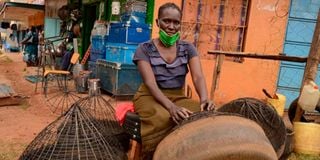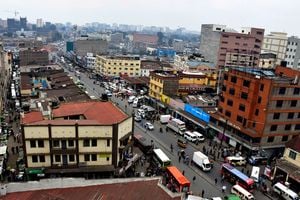For indigenous chickens to thrive, embrace cages

Esther Gachango, 43, makes chicken cages for sale in Ol Kalou, Nyandarua County in May 2020. Each cage goes for between Sh550 and Sh850 depending on size.
An innovation is a new or improved product or process or a combination of the two. The innovation thus differs significantly from previously used products and services as it has added socio-economic benefits.
More often than not, innovations are thought to be complex and unaffordable products and services. However, one simple innovation that has the potential to transform the rearing of indigenous chickens is the chick cage made from used vehicle tyres.
From disease to predation control in chicks, the cage can multiply profits in the indigenous chicken free-range farming system. Other innovations that enhance the cage’s potential include incubators that have the capacity to hold just a few eggs as well as commercial feed formulations designed for the various development stages of local birds.
Indigenous chicken
Poultry production contributes 4 per cent to the country’s gross domestic product, with indigenous chicken making about 75 per cent of the total birds in the country. These birds are produced by resource-poor farmers in the rural areas and their production contributes significantly to food security and poverty alleviation.
The birds are commonly reared in a free-range system where they scavenge for food in the compound and there is little supplementation with grains and kitchen remains. All the ages of birds and sexes scavenge together and the chicks have little to eat making them prone to diseases, stunted grow and high mortalities. They are also predisposed to predators that include mongoose, hawks, eagles and stray dogs and cats, among others. This reduces productivity of the indigenous birds whose eggs and meat are a delicacy.
Another challenge with indigenous birds’ production is the brooding nature of the mother hen. This is a situation where the hen lays a number of eggs in a batch/clutch and then sits on them for three weeks to hatch after which it takes care of them for another nine weeks before it can start producing eggs once again.
The process is repeated about three times in a year with the bird producing between 30 and 60 eggs. Research has shown that if the bird is prevented from brooding, the number of clutches can be increased to five in a year with an increase of about 18 or more in the same year. Rise in egg production is another way of increasing productivity in the farming system.
Used tyre cages
The cage has a circular base made of criss-crossing wires. The wires are extracted from used tyres through burning. The wires are then attached to a tyre that is lying on its side, from which another wire mesh system is added to form a conical structure. On one side of the cone is a small door that is used to let in chicks, hens, feed and water. The cage is sold in open air markets across the country. The factors that make the cage a novelty are:
Disease control: Disease control is not about drugs and vaccines only as housing also plays a major role. The cage protects chicks from bacterial diseases such as salmonella and E.coli; and also worms and other parasites
Predation control: The cage keeps off predators.
Mobility: It is easy to carry the cage from one place to another, thus during the day, it can be placed outside for the chicks to get sunshine and hence vitamin D while it is placed inside at night for safety of the birds. It is recommended that the cage be placed on a raised platform at night to control crawling insects such as mange mites and fleas
Brooding control: The use of the cage coupled with a heat source makes it possible for the mother to be relieved of its chick-care duties in which case it goes back to laying
Ease of feeding: With the cage, it is possible to feed the chicks separately, what results in speedy growth.
Isolation ward: Since local birds are not housed during the day, it becomes very difficult to isolate and treat sick birds. This forces farmers to place medicated water/feed in a strategic place in the compound for all the birds to take. The danger with the practice is that even healthy birds are exposed to medicines and with time, micro-organisms get used to these medicines hence anti-microbial resistance. This implies that the birds will not respond to treatment when treated with the same medicine in future.
Another challenge with the mass treatment of sick and healthy birds is the presence of small amounts (residues) of the drugs in the meat and eggs of such birds. The residues can cause anti-microbial resistance in drugs that treat the consumers.
They also predispose the consumer to allergy and cancer, among others. The cage, therefore, acts as an isolation ward for sick birds and due to the seclusion, the birds don’t continue spreading the disease, they recover fast and can thus be released to continue scavenging.





